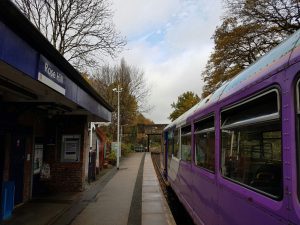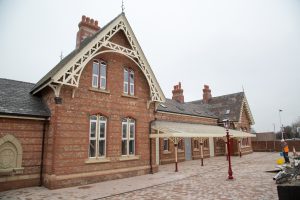When Transport for Greater Manchester’s head of rail, Amanda White, joined the body in 2014, it had one major goal in mind.
Manchester had just signed a devolution deal with Whitehall in which the city set specific objectives around the better integration of public transport in Greater Manchester.
One priority was to look at how stations are managed and whether the current model makes the most of the city’s assets.
Amanda joined TfGM from HS2, where she had been designing the route from Birmingham to Manchester. She had slowly been making her way up to the North West even then, she joked. For the past two years, one of her priorities has been to add some meat to the bones of Manchester’s rail devolution plan. The first substantial detail was published in TfGM’s ‘Case for Change’ document in March.
Although only a proposal at this stage, it clearly signals TfGM’s intentions. The authority said it wants to own and manage 97 stations around Greater Manchester, including Manchester Piccadilly. By owning the stations, TfGM can look at long-term investment programmes and tailor the facilities to match the communities they serve.
‘At the moment the rail stations are the missing piece of the jigsaw for us,’ says Amanda. ‘Because we can’t have as much influence as we do say with your Metrolink infrastructure or your bus infrastructure.’

She went on, ‘Even today, we don’t have any responsibility for the stations but we do receive the complaints, so there’s confusion about ownership now.’
Having worked in the industry for 14 years, Amanda understands all too well the network’s complex ownership structure. Prior to working for HS2, Amanda was at Network Rail. Out of university, she joined Network Rail’s electrification and plant division in York, eventually moving down to London to work on enhancement schemes.
She explained why she felt the current system wasn’t delivering for the city and wider county on the issues of . ‘The rail industry is focussed on running trains, they’re not incentivised,’ said Amanda, adding that the industry doesn’t have a remit to explore opportunities for local regeneration or integrated travel.
Starting with the basics
Of the 97 stations mentioned in the document, around half are unmanned and three of them serve the Glossop line outside the Greater Manchester boundary. The largest by far is Manchester Piccadilly, the fourth busiest station outside of London.
From the day it receives the keys, TfGM says it will look to rebrand and deep clean the stations, first targeting what it can immediately improve – things like access and comfort. ‘We’re starting with the basics and building up,’ says Amanda.
Long-term plans have already been produced for 21 stations. Over the next 18 months, plans for the remaining 76 will be drawn up. In particular, they are looking at what services could be offered at stations to address certain community issues, says Amanda. A desk for community support offices could be created at stations with high levels of antisocial behaviour, for example.
TfGM’s role in shaping rail services in the North West has been growing for some time. As part of Rail North, it was one of the strategic partners whose feedback helped define the specification for the current Northern and TransPennine franchises. But the same kind of partnership wouldn’t allow TfGM to achieve all of its aspirations, says Amanda.
‘You can get so far with a partnership or alliance but you can never guarantee the delivery of the outcome that you’re looking for as a single owner or single responsible organisation.’
In the future, TfGM hopes to develop its capability, says Amanda. The idea of it operating services directly is not entirely unlikely and although a new 10-year operating concession was awarded for Metrolink earlier this year, TfGM may choose to follow Midland Metro and bring its tram services in-house in the future.
‘As our responsibilities grow and as our network grows it may be that in another eight years time when we’re considering what that contract looks like we might want to bring in-house, completely in- house, the operations and the maintenance work or it might be that we see that there are advantages to leaving it as a concession and that’s how we manage the rail stations.’

Solid foundations
TfGM already owns Horwich Parkway, which sits on the Manchester to Preston route. The initial outlining business case suggests that the 94 local stations could transfer to TfGM in the next two to three years. A target of the mid 2020s has been put on the three larger stations – Piccadilly, Victoria and Oxford Road.
All of the operational staff for these stations would be transferred over to TfGM – a move that will provide more long-term stability for those employees, says Amanda. She believes that the infrastructure already exists within TfGM to begin running a portion of those 94 local stations straight away.
‘It really depends where we end up,’ says Amanda. ‘If we have a big bang and we get what we’ve asked for here with the 94 then we’re going to need to bring in a mobilisation team with the expertise to write up the contracts, legal agreements and do all the condition assessment that’s required alongside that. But on a very, very small scale, we do have the foundations of the right kind of expertise right across the organisation.
‘We already have our facilities management team who directly manage the maintenance of facilities, management of bus infrastructure and our own property estate. We have a very strong commercial, legal and financial team who are running the contracts for Metrolink as they stand. Plus the rail team that exists today which has within it our own very small, but completely relevant, asset management process for managing Horwich Parkway station.’
Governance
When the current Northern franchise launched last year, new operator Arriva set out how it planned to improve its stations. It has an obligation to the Department for Transport (DfT) to deliver on these plans. Under the Case for Change proposals, TfGM will instead have a contractual obligation to the train operating companies and a political obligation to taxpayers.
Says Amanda, ‘We’ll have a contract and we will have performance measures that are monitored through that franchise, but secondly we will be monitored through taxpayers and our own governance through GMCA.’
The rail infrastructure itself would remain Network Rail property. Major events and maintenance activities would require the same kind of close working that already goes on in the background.
‘There is no doubt that whatever we do the train operating companies and Network Rail will be our partners because Network Rail are the ultimate landlord,’ says Amanda. ‘We will always have to seek their approval and work closely with them to protect their assets.’
There may also be more opportunities to support the work of station adopters and community rail partnerships.
Says Amanda, ‘What we should do is actually open up more doors, generate more funding, improve the number of opportunities and relationships that can be generated with the CRPs, so we’re not going to walk away from those relationships either.
‘We already sit within the steering groups that work with the CRPs, but we can bring in a whole host of other relationships with our health departments or our policing or skills and make the connections a lot easier.’
Transformation
Amanda was the only girl in her A-level physics class. She was also one of just three women out of 30 students to complete the university mechanical engineering course she was on. The rail industry presents opportunities to work on transformative projects, said Amanda.
‘With a project like HS2, it’s a legacy that you can leave, understanding that it’s my name behind that route design to Manchester. A lot of people will not like it, but I do actually sleep well at night knowing that we went through a process and a consultation which I know is the right thing to do for that infrastructure design and I’m proud of being part of that.’
Taking charge of Manchester’s stations may not transform the country in the same way as HS2, but the ripple effect could see more local authorities seeking greater control of their railways.






Comments are closed.